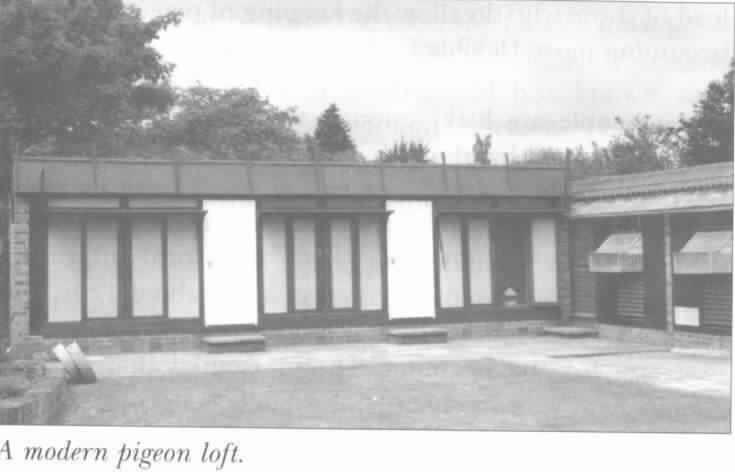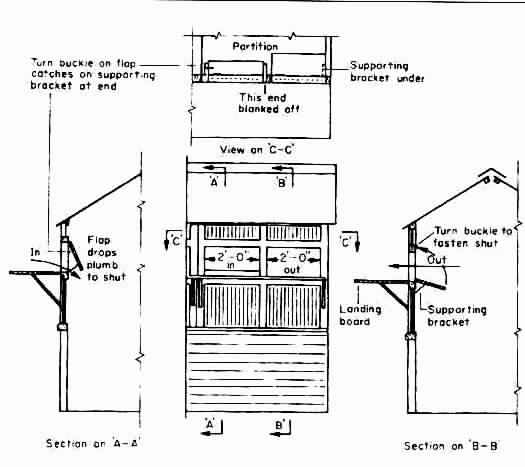| Author: Guy Barrett | Title: The Loft and its Fittings - (Chapter 2) |
| Date: 2002-09-09 19:23:05 | Uploaded by: webmaster |
|
One of the great difficulties which faces the beginer is the provision of a suitable loft in whichh to keep his pigeons. On the continent, most fanciers keep their birds in a convenient attic above the bedrooms. Whilst this undoubtedly makes a wonderful home for the pigeons, and is certainly handy for the fancier, it is not, I imagine, always equally appreciated by the rest of the family. The idea never became popular in Britain, and in any case, it would not nowadays be allowed by the local authorities.
If the potential fancier is fortunate enough to own a piece of land where he can erect a wooden loft, this should not present such dificulty, although he may have to obtain clearence for his plans from the local authority. But many people live in houses renter from the local council, and their permission must certainly be obtained before a loft can be built. Some local authorities, unfortunately, do not allow pigeon lofts to be built in the gardens ajoining their houses, but many do now agree to fanciers keeping pigeons providing that the lofts conform to a laid-down standard and are kept in a good state of repair. Councils are begining to realise, I believe, that on account of the shorter hours which will be worked in the future, people must have one or more hobbies to occupy their leasure time, and consequently more and more are following the lead of those who do allow the keeping of pigeons, and are becoming more fexible in their outlook.
Some people are lucky enough to have a suitable building near at hand which can be turned intoa loft, but failing this, they should either buy one of the excellent lofts advertised in the Fancy magazines or procure a suitable wooden building or shed. The local authorities usually allow their tennents to erect a loft about 12 to 14ft long 7ft deep and 7ft high. This is probably about the best size for the beginner. It is essential that the loft should have a roof which is absolutely waterproof. The inside must be completely free from damp, because it is impossible to condition pigeons in a damp loft. The fancier must see to it that the roof is covered with a layer of water proof felt, and if this layer is nailed down to the boards, and a further layer is stuck to it with bitumen-based cement, so much the better!
The loft should be erected on brick piers so that is stands a foot or so off the ground: this will prevent the bottom parts of the timber from rotting and will help to keep out the vermin. In the northern hemisphere it should be fixed so that it faces as near due south as is practicable. Pigeons enjoy sunshine, and enjoy nothing better to sit and bask in it. Next, it must be fitted with a wooden floor of close-boarded tongued and grooved boards - this will make for easy cleaning.

Having procured or erected a suitable building, it should be divided into two compartments, each about 6 or 7ft wide. One of these will be used for Old Birds, and the other for Young Birds. The partition can be made either solid or of laths, but it must have a door to enable the fancier to move from one part to the other. The two halves will also serve as seperate lofts for the cocks and hens in the winter, when the sexes are seperated. It is usual to fill in the front of the loft above the dado height with dowls, say ½ in. in diameter and 2 in. apart (however it is now popular to have a completely closed-in loft - Team). These should be covered, on the outside, with wire netting, or 'Weldmesh', to prevent the entry of sparrows. I prefer this combination to having wire-netting by itself as the birds, tend to cling to the netting with thier feet, and this bends the tail feathers and wing flights. Sparrows should be kept out as there is no doubt that they carry disease, and they certainly foul the drinking water. It is amazing how quickly these birds will find their way into a pigeon loft in their never-ending search for food!
It will be necessary to provide a "trap" to each compartment (a door will suffice - Team), which is the name we give to the opening by which the pigeons can enter and leave the loft. This can be shown in my sketch:

It is simple to make, and is the type of trap which I use in my own loft. It will be seen that one part (B-B in the illustration) allows the birds to go out and in, which the other part (A-A in the illustration) allows the birds to enter only. This enables the fancier to leave the loft open to birds returning from a training "toss", or from a race, whilst birds already in the loft are prevented from going out. A landing-board must be fixed, on which the birds can pitch before entering the loft. This should be the full length of the loft and about 2ft wide. An alternative trap is a sputnik. This style of trap also allows a fancier to control the departure and arrival of birds and is available from most accessory suppliers or can be made using wood and perspex.
Particular attention must be paid to the ventilation of the loft. This should be good, but draught-free. No amount of cold will harm pigeons, but they do not like draughts.
Ideally, fresh air should enter the loft at the bottom front, and the stale air should leave at the top back. Many lofts have louvres in the front, beneath the dowels, by which the fresh air enters. These should be designed so that the pigeons inside the loft cannot see marauding cats or dogs which happen to pass in front and which might frighten them. The louvres should be covered with half-inch mesh wire-netting to prevent the entry of vermin. Holes drilled at the back of the loft, below the roof, and again covered with wire-netting, will allow the stale air to leave.
Next, it will be neccessary to provide perches. "Box Perches" are probably the easiest to make, and I believe that they are the best. They should be about 10 or 11 in. square, and 4 or 5 in. deep - although for the Young Bird compartment, I prefer them to be 8 or 9 in. deep. This makes for easy catching of the Young Birds when basketing for a training toss or race. These box-perches can be made in groups of four, six or more, and should be fixed to the walls of the loft with metal brackets, so that they can be removed when required.
In the Old Bird compartment, nest-boxes will be required. These should be at least 2ft wide, 16in. high, and about 16in. deep. If the Old Bird compartment is 6ft. wide, it will be possible to accommodate nine such boxes in three tiers of three. these boxes can be removed in the winter and replaced by the box-perches. There are many different kinds of nest-box front. The main thing is that they should be either removable, or hinged, so that the insides of the boxes can be cleaned. And they must, of course, have a door by which the birds can enter, and which be used to shut them in, when this is required.
Having completed the loft and its fixtures, we must now turn our attention to the various loose fittings which are needed. Firstly a water fountain will be required for each compartment; also troughs for food. The troughs can be made simply, as shown in the sketch, from two pieces of 3in. by 3/8 in. timber.

Various small pots for grit etc., are easily obtained. Two nest bowls will be required for each nest-box, and a supply of pot eggs - two per pair of birds. A galvanised iron pigeon bath, watering can, and various cleaning utensils (scraper, brush, shovel etc.) complete the loose fittings. All these items can be found at a good pet store, or at some ironmongers.
Lastly, and this is most important, fix a strong padlock on the loft door. Even the best lock may not stop a determined thief, but he who does not even attempt to deter the burglar is hardly in a position to complain if his pigeons are stolen!
Each year a number of fanciers lose their birds in this way and, although the birds often return to their owners, they are in many cases minus their metal rings, which of course, renders them useless for further racing.
The loft which I have described is of the simplest type, and therefore is the easiest to construct, put pigeons will race just as well to a small, well-constructed loft as they will to a palace! There are, it is true, many different kinds of loft housing winning birds, and there are many sorts of trapping arrangments. Many fanciers swear by the "open door" method which, as it allows the birds to fly directly into the loft without alighting outside, may enable the fancier to time in more quickly, but it has its disadvantages. Unless the openings are sufficiently high off the ground, marauding cats can very easily enter and create havoc among the birds and it can take months, or even years, for the pigeons to get over such an experience. It is therefore important to ensure that the loft is proof against cats, as far as possible. If there are cats about, a wire-netting fence erected some distance from and around that loft can prevent them from coming too near.
The pigeons must be able to regard their loft as a safe, comfortable refuge where they can spend their waking and sleeping hours secure from all dangers. As a pigeon grows older, it develops more and more a tremendous love for its home, and the fancier should do all he can to foster and encourage this in his ambition to become a successful pigeon racer.
Used with permisson. © RPRA.
|
| Coo time for a brew!...Where next? |
| Lets hear what you've got to say on this issue.... or any other infact! Post your comments in the Message Forum. |
| You've seen the light... bang a new idea!!... Tell the world, Write an article for Pigeonbasics.com, email into the webmaster at webmaster@pigeonbasics.com. |
|
|

